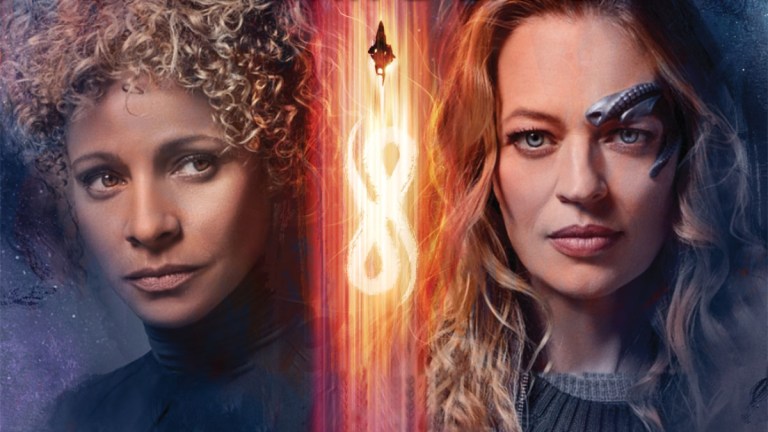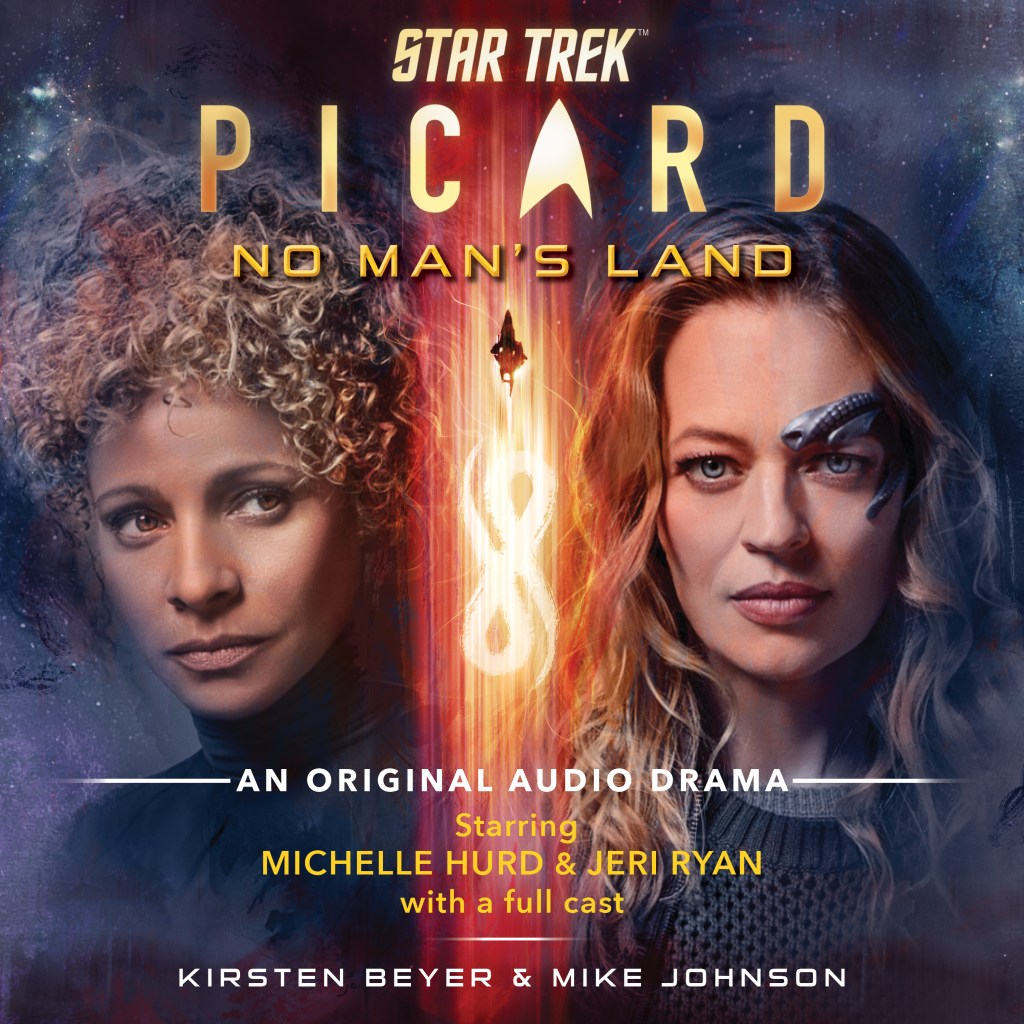How a New Picard Adventure Proves Star Trek Books Are Canon
A new Star Trek audio adventure fills in the gaps between the first season and Star Trek: Picard season 2. And yes...it counts!

Star Trek’s relationship with tie-in media, specifically books and comics, is one of the largest and most expansive in the history of science fiction. Before the explosion of the Star Wars “expanded universe” of novels in 1991, Star Trek had been putting out at least four novels every year since 1980. This output hasn’t really changed much since the ‘80s, and though the official canonicity of Trek novels remains intentionally vague, there’s a long tradition of the writers of books and comics making every effort to make what tie-in media match with what you see on screen. But hardcore fans want to know, what counts and what doesn’t? Does what happens in the comic books, novels, and now, audio drama adventures, really count?
Co-writers of the new audio drama Star Trek: Picard – No Man’s Land — Kirsten Beyer and Mike Johnson — want fans to know one thing: They think it all counts.
“Before I was working on the shows, I was doing the novels and that was the only Star Trek out there,” Kirsten Beyer says. “So you know, it had better count!”
A producer on Star Trek: Discovery, a co-creator of Star Trek: Picard, and now, a writer for Star Trek: Strange New Worlds season 2, Beyer’s Trek career began as a writer of Star Trek: Voyager novels. Her first book in that series, String Theory: Fusion, was published in October 2005, a full four years after Voyager ended on TV, five months after Enterprise aired its final episode, four years before the 2009 Star Trek reboot film, and twelve years before Discovery would relaunch Star Trek on TV. So, when you look at it from Beyer’s point of view, half of her Trek writing career existed in the liminal space of so-called “real canon.”
“We have set a standard for ourselves of telling the best stories that we can in whatever medium we’re working in, across the board,” Beyer says. “And that never changes.”
Beyer’s co-author on Picard: No Man’s Land, Mike Johnson, doubles down on this assertion, saying, “When I was doing the Kelvin [comics] for IDW, that was the only Kelvin universe stuff out there in between the movies. Anyone working on a project thinks of it as canon, otherwise, you’re doing a disservice to yourself and the fans.”
He also points out that in numerous tie-in materials since 2009, there has been a close working relationship between the writers of the films and the TV shows, and those producing the comics and novels. “I’m not saying that any writer who doesn’t have direct communication is somehow lesser. But I had Bob Orci as a sounding board for the Kelvin comics, and now I have a similar benefit, given Kirsten’s involvement with the shows.”
Like Beyer, Johnson has been writing Star Trek material for a very long time, starting with the popular IDW comic book series Countdown, which created a kind of TNG-era prequel for the events of the 2009 film. Obviously, not all of the material from that comic has remained canon in the post-Picard era, but at the time, the intent was there to give the fans something that was specifically made for them. This philosophy extends to many of Johnson and Beyer’s other collaborations, including the Discovery prequel comic The Light of Kahless, the Mirror Universes sequel Discovery: Succession, and the popular series Picard: Countdown, which not only shows Raffi and Jean-Luc during their Starfleet heyday but also elaborates on the origin story of Laris and Zhaban, including exactly how and why the came to work for Jean-Luc in the first place. The point is when it comes to extracurricular Star Trek action, Beyer and Johnson know their stuff.
This leads to what is perhaps their most ambitious project to date — No Man’s Land — a full-cast audio drama featuring the machinations of Seven of Nine (Jeri Ryan) and Raffi (Michelle Hurd) in between the events of Star Trek: Picard seasons 1 and 2. While the story was being developed alongside the writing of season two, Beyer reveals that Ryan and Hurd recorded it just after they had finished filming the second season. So, if fans feel a synergy between what they see of Seven and Raffi in Picard season 2 and what they hear in No Man’s Land, that’s the goal. “We had the benefit of really knowing where season two was going and were able to make little adjustments as we went along in terms of tone,” Beyer explains. “We were really able to fine-tune it as season two was happening.”
To be clear, No Man’s Land is not an audiobook adapted from prose. This is an audio drama with a full cast — including Star Trek: Lower Decks’ Fred Tatasciore in an entirely different role — and a plot that feels like a Star Trek film, or a big multi-part episode arc. Without spoiling it, the story concerns Seven, Raffi, and a crew of Fenris Rangers, in pursuit of a missing professor and a mysterious artifact which is also on the want-list for a Romulan warlord. For the most part, the action is removed from the Federation and Starfleet and allows us to experience the unique differences between what is going on in Fenris Ranger territory and the rest of the galaxy.
“It’s the core purpose of writing an ancillary project like this,” Johnson explains. “You don’t want to rewrite anything that’s come before, but you don’t want to step on the toes of anything that’s ahead. So, we carved out a location and a cast that wouldn’t conflict with season two of Picard, but would also contribute to Seven and Raffi’s story in Picard.” Johnson also says that if fans feel like Seven and Raffi are on a kind of Indiana Jones-esque adventure, then they’ve certainly caught the flavor.
“I even wanted to call our missing professor ‘Ravenwood’ at some point,” Johnson admits. He also adds that some aspects of No Man’s Land were influenced by the standalone Star Wars novels of the ‘70s and ‘80, specifically Brian Daley’s Han Solo at Star’s End. In the same way that those novels isolated Han Solo in a different section of space, away from the action of the films, No Man’s Land keeps Seven and Raffi in the area of space near where the Romulan Empire used to exist, before the supernova from the 2009 Trek film, blew everything up.
“I was really interested in is always continuing to go deeper into the sort of geopolitical landscape of what the universe is gonna feel like post-[Romulan] supernova,” Beyer says. “That’s so important to the series as a whole. The notion that people would have tried to save the cultural artifacts of what came before. There are so many ways [the supernova] changed the lives of so many people. And the more you can find that kind of thing, the more you can make it the whole thing richer for everybody.”
For fans who are curious as to what happened in the year-and-a-half gap between Picard seasons one and two, the audio drama No Man’s Land certainly helps to answer some of your questions, particularly when it comes to Seven and Raffi’s break-up. But, Kirsten Beyer makes it very clear that this isn’t the entire story of Seven and Raffi pre-Season 2.
“This is one thing that happened to them!” Kirsten Beyer says with a laugh. “It’s not the only thing that happened to Seven and Raffi.” Clearly, the Raffi-Seven adventure is just beginning.

Star Trek: Picard: No Man’s Land is written by Kirsten Beyer and Mike Johnson, with a full cast starring Michelle Hurd, Jeri Ryan, Jack Cutmore-Scott, John Kassir, Fred Tatasciore, Chris Andrew Ciulla, Lisa Flanagan, Gibson Frazier, Lameece Issaq, Natalie Naudus, Xe Sands, and Emily Woo Zeller is available on Simon and Schuster Audio. If you have Audible, you can snag it with your monthly credit.
